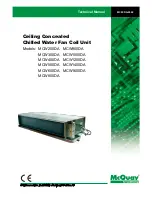
31
YORK INTERNATIONAL
FORM 150.52-NM2 (1001)
diameters on either side of the flow switch. The flow
switch should be wired into Terminals 13 and 14 (See
Figures 11 and 12.) For details refer to “Electrical Con-
nection”. A flow switch is required to prevent dam-
age to the cooler caused by the unit operating with-
out adequate liquid flow. The flow switch MUST
NOT be used to start and stop the unit.
The flow switch used must have gold plated contacts
for low voltage/current operation. Paddle type flow
switches suitable for 10 bar (150 PSIG) working pres-
sure and having a 1" N.P.T. connection can be obtained
from YORK as an accessory for the unit. Alternatively,
a differential pressure switch sited across an orifice plate
may be used, preferably of the high/low limit type.
The chilled liquid pump(s) installed in the pipework
system(s) should discharge directly into the unit cooler
section of the system. The pump(s) may be controlled
external to the unit - but an override must be wired to the
control panel so that the unit can start the pump in the
event that the liquid temperature falls below the mini-
mum setting. For details refer to “Electrical Connection”.
Pipework and fittings must be separately supported to
prevent any loading on the cooler. Flexible connections
are recommended which will also minimize transmis-
sion of vibrations to the building. Flexible connections
must be used if the unit is mounted on anti-vibration
mounts as some movement of the unit can be expected
in normal operation.
Pipework and fittings immediately next to the cooler
should be readily demountable to enable cleaning be-
fore operation, and to facilitate visual inspection of the
exchanger nozzles.
The cooler must be protected by a
strainer, preferably of 30 mesh, fitted
as close as possible to the liquid inlet
connection, and provided with a
means of local isolation.
The cooler must not be exposed to flushing velocities or
debris released during flushing. It is recommended that
a suitably sized by-pass and valve arrangement is in-
stalled to allow flushing of the pipework system. The
by-pass can be used during maintenance to isolate the
heat exchanger without disrupting flow to other units.
Thermometer and pressure gauge connections are fur-
nished by others, and should be provided on the inlet
and outlet connections of each cooler.
Drain and air vent connections should be provided at all
low and high points in the pipework to permit complete
drainage of the cooler and system piping, as well as to
vent any air in the pipes. Hand stop valves are recom-
mended for use in all lines to facilitate servicing.
Liquid systems at risk of freezing, due to low ambient
temperatures, should be protected using insulation and
heater tape and/or a suitable glycol solution. The liquid
pump(s) must also be used to ensure liquid is circulated
when the ambient temperature approaches freezing point.
Insulation should also be installed around the cooler
nozzles. Heater tape of 21 watts per meter under the
insulation is recommended, supplied independently and
controlled by an ambient temperature thermostat set to
switch on at 21°C (37°F) above the freezing tempera-
ture of the liquid.
The liquid circulation pump must be controlled by the
unit. This will ensure that when the liquid temperature
falls within 2° or 3°C (3° or 5°F) of freezing, the pump
will start.
The cooler is protected by heater mats under the insula-
tion, which are supplied from the unit control system
power supply. During risk of freezing, the control sys-
tem should be left switched on to provide the freeze
protection function, unless the liquid systems have been
drained.
Any debris left in the water pipework
between the strainer and cooler could
cause serious damage to the tubes in
the cooler and must be avoided. The
installer/user must also ensure that the
quality of the water in circulation is
adequate, without any dissolved gases
which can cause oxidation of steel
parts within the cooler.
WATER TREATMENT
The unit performance given in the Design Guide is based
on a fouling factor of 0.044m
2
/hr °C/kW (0.00025
ft
2
hr°F/Btu). Dirt, scale, grease and certain types of
4
















































